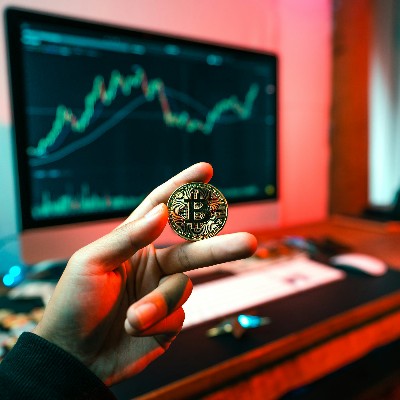
سعر SolanaPrimePRIME
معلومات عن سوق SolanaPrime
سعر SolanaPrime الحالي اليوم بعملة AED
والآن بعد أن عرفت سعر عملة SolanaPrime اليوم، إليك ما يمكنك استكشافه أيضًا:
طريقة شراء عملة مشفرةكيفية بيع العملات المشفرةتعريف SolanaPrime (PRIME)ما أسعار العملات المشفرة المماثلة اليوم؟هل تريد الحصول على العملات المشفرة على الفور؟
اشترِ العملات المشفرة مباشرةً باستخدام بطاقة ائتمان.تداول مجموعة متنوعة من العملات المشفرة على منصة التداول الفوري للمراجحة.توقعات سعر SolanaPrime
ماذا سيكون سعر PRIME في 2026؟
في 2026، بناءً على توقعات معدّل النمو السنوي بنسبة +5%، من المتوقع أن يصل سعر SolanaPrime(PRIME) إلى د.إ0.00؛ وعلى أساس السعر المتوقع لهذا العام، سيصل عائد الاستثمار التراكمي على استثمار SolanaPrime والاحتفاظ بها حتى نهاية 2026 إلى +5%. لمزيدٍ من التفاصيل، يُرجى الاطلاع على SolanaPrime توقعات أسعار لعملتي 2025 و2026، لعام 2030-2050.كم سيكون سعر PRIME في عام 2030؟
نبذة حول SolanaPrime (PRIME)
SolanaPrime Token :عملة مشفرة تحت الأضواء
SolanaPrime Token، وهي رمز رقمي يخطو خطواته الأولى في عالم العملات المشفرة، يتميز بالابتكار والمرونة والإمكانات الهائلة.
تقدم بيئة SolanaPrime تقنيات متقدمة ومتطورة تزيد من الكفاءة والأمان للمستخدم. وتعد هذه البنية التحتية المتقدمة واحدة من العوامل الرئيسية التي تجعل SolanaPrime واحدة من أكثر العملات المشفرة إثارة للاهتمام في السوق.
الاستثمار في SolanaPrime ليس فقط عن اقتناء رمز سولانا برايم الرقمي، بل هو أيضًا عن المساهمة في بنية تحتية تقنية عالمية استثنائية تهدف إلى تحقيق ثورة في عالم العملات المشفرة وتحسين كيفية تنفيذ المعاملات الرقمية وتطوير العقود الذكية.
ميزات SolanaPrime Token
أحد العوامل التي تميز SolanaPrime Token عن العديد من العملات المشفرة الأخرى هو نظام الأمان الفريد الذي يحمي جميع المعاملات داخل بيئة SolanaPrime الرقمية.
الواقع أن تخزين العملات المشفرة في SolanaPrime أكثر أمانًا وأقل تعقيدًا بسبب التقنيات المتطورة التي تم تطبيقها على النظام.
أهمية SolanaPrime في سوق العملات المشفرة
استخدام SolanaPrime Token ليس فقط للتداول في السوق، بل يمكن أيضًا استخدامه كوسيلة لتحقيق الربح من خلال الاستثمار في العقود الذكية والتطبيقات اللامركزية وغيرها من التقنيات الرقمية المتقدمة التي يتم تطويرها داخل بيئة SolanaPrime.
يقدم SolanaPrime Token فرصًا فريدة للمستثمرين والمطورين على حد سواء، مما يجعله أحد اللاعبين المهمين والمرنين في السوق.
في الختام، تتطور SolanaPrime Token بسرعة وتتوقع الكثير من النجاح في المستقبل. فهو يتميز بالابتكار والمرونة والأمان، مما يجعله خيارًا جذابًا للمستثمرين والمطورين الذين يبحثون عن الابتكار والفرص في عالم العملات المشفرة.
رؤى Bitget



ماذا يمكنك أن تفعل بالعملات المشفرة مثل SolanaPrime (PRIME)؟
الإيداع بسهولة والسحب بسرعةاشترِ لتنمو، وبع لتربحالتداول الفوري للمراجحةتداول العقود الآجلة للمخاطر العالية والعائد العالياكسب دخلًا ثابتًا بمعدلات فائدة مستقرةتحويل الأصول باستخدام محفظة الويب 3 الخاصة بكمعلومات عن SolanaPrime وآلية عمل SolanaPrime
شراء المزيد
الأسئلة الشائعة
ما السعر الحالي لـ SolanaPrime؟
ما حجم تداول SolanaPrime على مدار 24 ساعة؟
ما أعلى مستوى على الإطلاق لـ SolanaPrime؟
هل يمكنني شراء SolanaPrime على منصة Bitget؟
هل يمكنني تحقيق دخل ثابت من الاستثمار في SolanaPrime؟
أين يمكنني شراء SolanaPrime بأقل رسوم؟
أسعار العملات المشفرة ذات الصلة
أسعار العملات المُدرجة حديثًا على Bitget
العروض الترويجية الرائجة
أين يمكنني شراء SolanaPrime (PRIME)؟
قسم الفيديو - التحقق السريع والتداول السريع!









